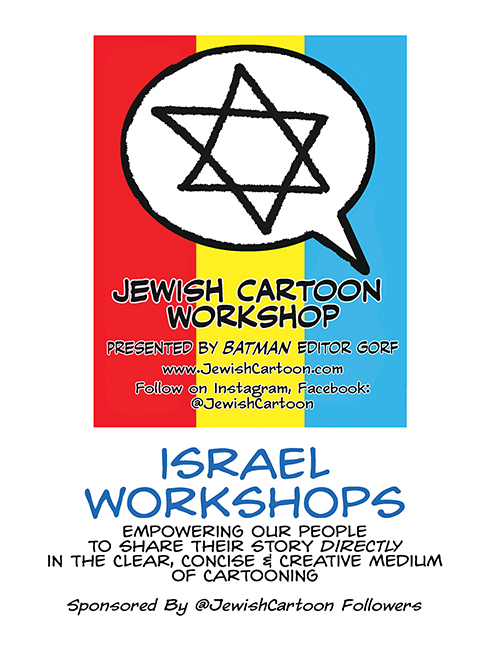
In January 2024, I was drawn to Israel to undertake a mission of one: to use cartooning to bear witness to October 7.
Background: For many years, at countless shuls, schools, JCCs and summer camps, I’ve run my Jewish Cartoon Workshop, a unique structured experiential storytelling exercise, empowering our people—of all ages and backgrounds—to use the same tools as professionals to share their Jewish-themed story themselves, in the clear, concise and creative medium of cartooning.
Participants use the skills we all already possess. No drawing skill required, really! If you can draw a stick figure, write words and tell a story—and everyone can—you can do this. The cartoons are then collected into a comic book so that everyone can enjoy and benefit from the cartoonists’ personal Torah, Judaism and Israel insights.
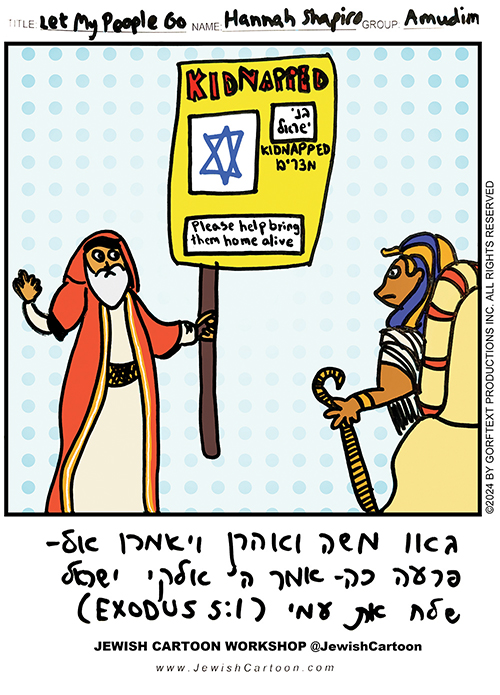
On one of my many scholar-in-residence weekends around the world (the Jewish Cartoon Workshop is the culmination of a weekend of discussions and presentations) a congregant observed that Jewish Cartooning—much like my Tanach graphic novels in collaboration with Koren Publishers—is the New Midrash. I like that.
The series of Jewish Cartoon Workshops in Israel drew from—and drew about—the diverse communities of nefunim (“displaced” people), from Kibbutz Be’eri in the south to Shlomi Kiryat Shmoneh in the north, exiled to a Jerusalem or Dead Sea hotel room for months on end. I also visited several yeshivot and midrashot gap-year programs.
These are their stories, told by them directly. To paraphrase from the Pesach Haggadah, Lo al y’dei mal’ach, lo al y’dei shaliach … elah b’cartoonim!
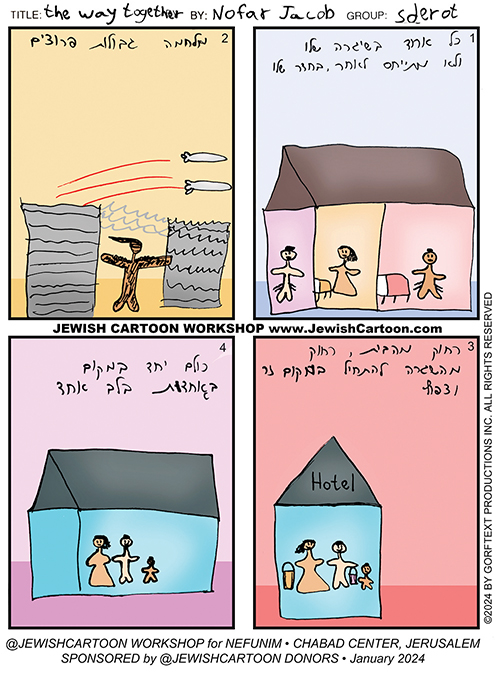
I’m providing midrash (commentary), but avoiding direct translation, to respect and preserve the creator’s original intent. Worry not: A good cartoon can be understood by the sequential illustration (the succession of art from panel to panel), no language necessary (see “Let My People Go” cartoon, Amudim seminary). These are more than just good cartoons. They represent important stories the world needs to know. Perhaps the disarming, sublime medium of cartooning can help them reach a wider audience.
“Let My People Go” by Hannah Shapiro was created at Amudim seminary in Jerusalem. The entire gap-year program participated. That week’s parsha happened to be Beshalach, which prompted their workshop theme: Encapsulate their year in Israel post-Oct. 7 through the events of Yetziat Mitzrayim.
“The Way Together” by Nofar Jacobs from the southern city of Sderot participated in a Jerusalem-based workshop. The Chabad of Talbiya converted a derelict, classic hotel into a refugee center. A boutique encompassing the entire upper level offers donated everyday items, from clothes to toiletries, to nefunim families who evacuated their houses with literally only the shirts on their backs. The main level consists of an activities space where, over warm soup and breakfast nosh, parents get a respite from their harried, homeless lives.
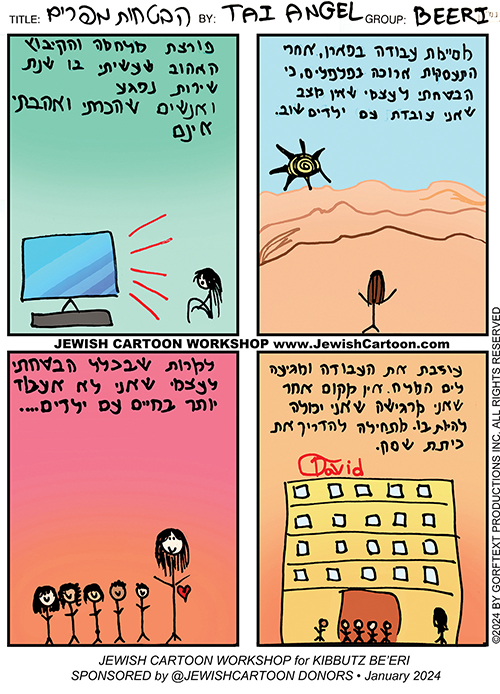
Nofar’s cartoon—read right to left, apropos to Hebrew—depicts how war forced them from their spacious house into a cramped hotel room. The last panel employs a wonderful “cartoon midrash” device: the non-literal image. Specifically:
The family is shown back in their house. But the scene combined with the narration clues the reader into its underlying metaphoric meaning. The message: Despite their hardship, as long as they’re together, home is where the heart is.
“Havtachot Mafrim” (“Broken Promises”) by Tai Angel is also read right to left. Tai told me the background to her cartoon. She actually isn’t displaced personally. A couple or so years back, serving her two years as a Bat Sherut in Israel’s national service, she was stationed at Kibbutz Be’eri and assigned to the gan. After a year dealing with the rather active kids in that nursery, she said, “I never want to be with these kids again!” After October 7, she ran to the David Hotel. As clearly depicted in the last panel, she had a change of heart. She said to me, “I never want to be separated from these kids again!”
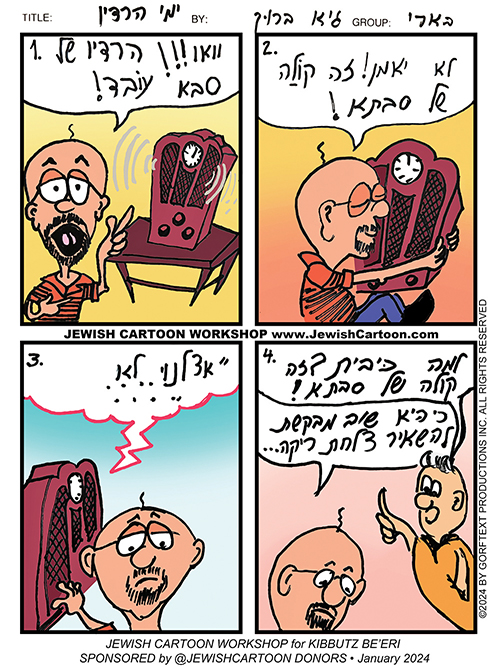
“Y’mei HaRadio” by Guy Baruch, or as I called him, SuperGuy. When I think kibbutz, I think refet and cows. Kibbutz Be’eri is so much more. Fun fact: The most prominent, and important, security (official badging, documents) printing facility in all of Israel is at Be’eri. I was told that the presses never stopped rolling, even on October 8.
Guy runs his own business on Be’eri, refurbishing old appliances, like cabinet stereos. He is a master craftsman, and people from all over the region send their antique technology to him to bring back to glorious life.
Which leads to his cartoon, created at the David Hotel, the home of about a third of the kibbutznikim, where they have recreated kibbutz life inside a vacation spot, most memorably with crates of fresh produce stacked in the hallways, sampled by children running barefoot as they would at home… (A story for another time!)
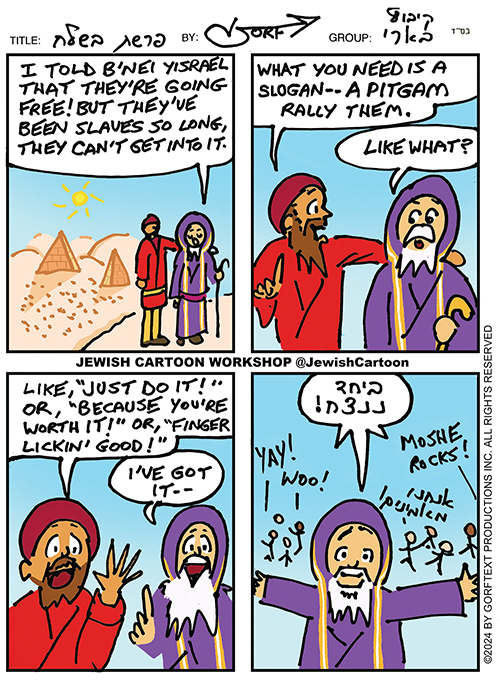
In the cartoon, Cartoon-Guy flips on a repaired radio—and hears the voice of his long-deceased grandmother! At first, Cartoon-Guy is amazed. Then he turns it off. His friend asks him, “Why?”
Originally, Guy’s final panel resolution was pat. I cannot recall the specifics, just that I suggested that he come up with a punchline, a funny or poignant ending, to make the cartoon memorable.
He hit it out of the park: Cartoon-Guy bemoans that all Savta is saying is, “Eat your vegetables, clean your room…” Funny and poignant!
And quite possibly a lot more.
A closer look at his punchline dialogue reveals, to me, an emotional subtext. (Fair disclosure: this is my “New Midrash”; I haven’t discussed it with Guy.) The specific Hebrew word that Cartoon-Guy uses is “reikah,” or “empty.” In the cartoon, he’s referring to an empty plate. I read a deeper meaning.
In Tel Aviv at Hostage Square, and elsewhere around the world, public displays to create awareness of those missing or captured feature table settings with placards for every name, placed by empty chairs—on empty plates. Perhaps the deceased grandparent represents the people of October 7.
One day, with everyone’s support, Kibbutz Be’eri will be rebuilt. Life will return. Guy will return to sitting on his porch on Shabbat morning, sipping his coffee. He will look to the house on his left and see his neighbors. Then he will look to his right … and his other neighbors are no longer there. He—we—will yearn to channel their voices one more time.

“You Need A Slogan!” My experience so uplifted and inspired me, I couldn’t help creating one cartoon myself. In Israel, one slogan was ubiquitous: “B’yachad N’natzeach,” splashed on posters, street signs, even tissue boxes. While one may interpret the words literally as “Together, We’ll Be Victorious,” my New Midrash interprets the words in the heartwarming spirit exemplified by my fellow cartoonists: “United We’ll Persevere.”
Am Yisrael Chai.
Follow Jordan B. Gorfinkel, www.jewishcartoon.com, Instagram: @jewishcartoon
* Additional Credit: Color on the cartoons by intern Rachel Max.













